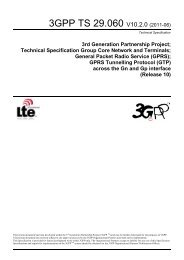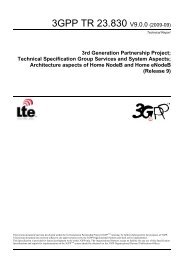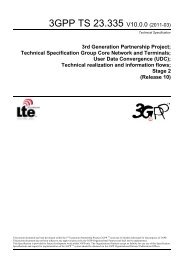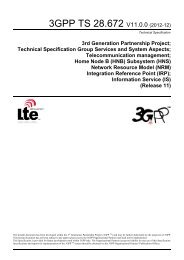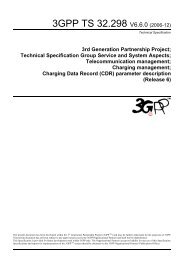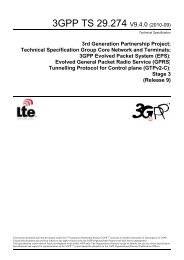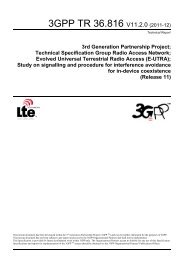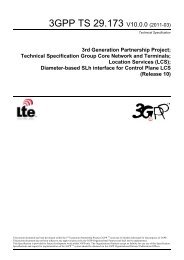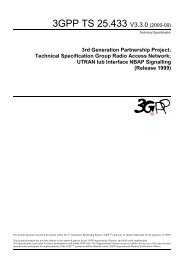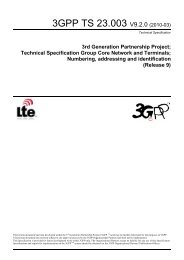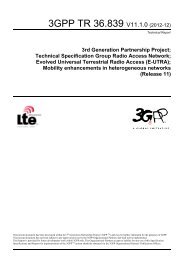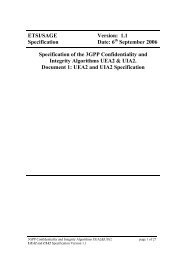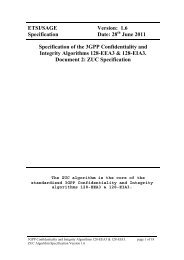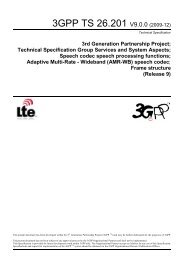3GPP TS 36.212, "Multiplexing and channel coding"
3GPP TS 36.212, "Multiplexing and channel coding"
3GPP TS 36.212, "Multiplexing and channel coding"
Create successful ePaper yourself
Turn your PDF publications into a flip-book with our unique Google optimized e-Paper software.
Release 8<br />
8<br />
<strong>3GPP</strong> <strong>TS</strong> <strong>36.212</strong> V8.1.0 (2007-11)<br />
Table 4.2-1<br />
TrCH<br />
DL-SCH<br />
BCH<br />
PCH<br />
MCH<br />
Physical Channel<br />
PDSCH<br />
PBCH<br />
PDSCH<br />
PMCH<br />
Table 4.2-2<br />
Control information<br />
CFI<br />
HI<br />
DCI<br />
Physical Channel<br />
PCFICH<br />
PHICH<br />
PDCCH<br />
5 Channel coding, multiplexing <strong>and</strong> interleaving<br />
Data <strong>and</strong> control streams from/to MAC layer are encoded/decoded to offer transport <strong>and</strong> control services over the radio<br />
transmission link. Channel coding scheme is a combination of error detection, error correcting, rate matching,<br />
interleaving <strong>and</strong> transport <strong>channel</strong> or control information mapping onto/splitting from physical <strong>channel</strong>s.<br />
5.1 Generic procedures<br />
This section contains coding procedures which are used for more than one transport <strong>channel</strong> or control information type.<br />
5.1.1 CRC calculation<br />
Denote the input bits to the CRC computation by a 0 , a1,<br />
a2<br />
, a3,...,<br />
a A −1<br />
, <strong>and</strong> the parity bits by p 0 , p1,<br />
p2<br />
, p3,...,<br />
p L −1<br />
. A<br />
is the size of the input sequence <strong>and</strong> L is the number of parity bits. The parity bits are generated by one of the following<br />
cyclic generator polynomials:<br />
- g CRC24A (D) = [D 24 + D 23 + D 18 + D 17 + D 14 + D 11 + D 10 + D 7 + D 6 + D 5 + D 4 + D 3 + D + 1] <strong>and</strong>;<br />
- g CRC24B (D) = [D 24 + D 23 + D 6 + D 5 + D + 1] for a CRC length L = 24 <strong>and</strong>;<br />
- g CRC16 (D) = [D 16 + D 12 + D 5 + 1] for a CRC length L = 16.<br />
The encoding is performed in a systematic form, which means that in GF(2), the polynomial:<br />
a<br />
A+<br />
23 A+<br />
22<br />
24 23 22<br />
0 D + a1D<br />
+ + a A−1D<br />
+ p0<br />
D + p1D<br />
+ ...<br />
... + p D + p<br />
yields a remainder equal to 0 when divided by the corresponding length-24 CRC generator polynomial, g CRC24A (D) or<br />
g CRC24B (D), <strong>and</strong> the polynomial:<br />
a<br />
A+<br />
15 A+<br />
14<br />
16 15 14<br />
0 D + a1D<br />
+ + a A−1D<br />
+ p0<br />
D + p1D<br />
+ ...<br />
... + p D + p<br />
yields a remainder equal to 0 when divided by g CRC16 (D).<br />
The bits after CRC attachment are denoted by b 0 , b1<br />
, b2<br />
, b3<br />
,..., b B −1<br />
, where B = A+ L. The relation between a k <strong>and</strong> b k is:<br />
b k = a k for k = 0, 1, 2, …, A-1<br />
b<br />
= for k = A, A+1, A+2,..., A+L-1.<br />
k p k − A<br />
14<br />
22<br />
1<br />
1<br />
15<br />
23<br />
<strong>3GPP</strong>



